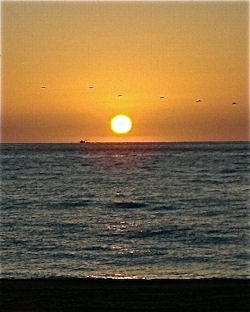 |  |
By Georgia Tanner

The Gulf of California is an inland sea that heats up as the summer progresses. The northern Gulf is shallow; by July water temperatures are in the 80s and by August they can reach 90. The Gulf lacks the west coast’s natural air conditioning: fog or clouds drawn inland by the cool Pacific Ocean. And other parts of Baja can sizzle during the summer, so a visitor or resident needs to know how to tolerate the heat.
The first summer I lived next to Baja’s desert sea was The Idiot’s Guide to Heat Survival. The daily lessons included personal experiments, heeding local wisdom, reading Xavier Maniguet’s book Survival, and observing Mother Nature. What I discovered allowed me to enjoy four more summers without air conditioning.
The first thing I learned was that "hammock" is a verb. Totally relaxing the body and mind can be almost as important as drinking plenty of water. Saving strenuous tasks for morning hours and moving slowly at all times helps to avoid the irritation and confusion that can come with spending time in the heat.
Paradoxically, spending time in the heat is just what is needed in order to acclimate. After several days of exposure to heat, the body begins to adapt. Increased sweating and consequent calorie loss lowers skin temperature and cools the circulating blood; mineral salt content decreases; blood distribution in different tissues returns to normal and protects against fainting or abdominal cramps; cardiac output is elevated but returns to normal gradually.
These adaptations occur within four to seven days; acclimating is complete by 12 to 14 days. Which is why it’s important to stay in one place and not run back and forth between cool and hot climates.
"Drink electroytes," a neighbor told me, and that was great advice. Electrolytes boost energy and replace minerals lost through the pores. If electrolyte drinks aren’t available, a home brew can be made by adding a pinch of salt, a few spoonfuls of brown sugar and three or four ounces of grape juice to a quart of water; brown sugar and grape juice both contain potassium.
A local event revealed why another kind of drink is not recommended: "Help! HELP! My husband has collapsed!" cried a woman over the marine radio used for communication in the "South Campos," off-the-grid residential camps south of San Felipe. Several people answered with offers of help. Our volunteer fire chief called for an ambulance and, 30 minutes later, verbally guided it to the distressed man’s house. The man survived the 30-mile trip north to San Felipe’s hospital, in spite of ignoring the weatherman’s advice for extreme heat: "Drink plenty of nonalcoholic beverages." (Apparently he substituted beer for water.) Diagnosis: acute dehydration.
In the heat, it’s vital to drink water consistently and in small amounts--several quarts during the day to replace loss from sweating--and to drink before feeling thirsty; thirst is a warning that dehydration has begun.
Water is essential for every function in the body. Physical symptoms of chronic dehydration include stiff joints, dry scaly skin that loses its elasticity, reduction of tears, saliva, and urine. Mental symptoms include apathy, depression, and confusion. Chronic dehydration can even cause "pseudo senility;" many cases of “senile dementia” can be cured simply by drinking water.
A few tricks proved useful when conditions became uncomfortable. I hung more shadecloth. I wore wet clothes until they dried or misted bare skin with a spray bottle. I imitated the black part-labrador dog who came to visit by joining him at the edge of the sea where we sat side by side, letting little wind waves lap over us. I imitated the cat, flat-out on the floor near a 12-volt fan. At night I stayed high, on the sundeck, to avoid the day’s heat radiating out of the sand and to catch early morning land breezes flowing seaward. Anthropologists theorize that humans developed the ability to walk upright as an aid to heat survival; heat at ground level is more intense than the air several feet higher.
Besides the aforementioned tools like shadecloth and a battery-operated fan, toys for playing in the sea can provide both safety and fun. Be aware that stingrays may be present in sandy areas, and May-June is their breeding time, so where there is one there may be two. Doing the “stingray shuffle”--pushing your feet ahead without lifting them from the sand--will scare them away. I like to launch into deeper water with the help of a boogie board and fins; surfboards work great too, but fins give power if you want to swim. A board of some sort also provides added height above sea level, which helps to spot and avoid the odd jellyfish that may come in with the tide in very warm water. And don’t forget noodles; a roll of foam under your knees and one under your head creates a water hammock.
Another summer secret is beautiful space: there’s almost no one around but the local wildlife. And with no one around, clothing is optional. On humid nights when clouds drifted in front of the stars, I took a shower from a bag hung under the palapa and cooled off while watching lightning displays over the horizon of Baja’s desert sea.

great company to work with! Easy to obtain, thank you!

Easy, fast, and affordable.

By far the best service for Mex insurance in Baja. They are personally there for you if you have...